From the beginnings of silent films to the talkies we have now, women have played a pivotal role in the development of film whether it be behind the scenes or on the screen. In early theater, women challenged gender roles and sparked debates over women’s place in public life. To celebrate these pioneers for women’s history month, we’ve compiled a list of essential reading from our books and journals.

Starring Women: Celebrity, Patriarchy and American Theater 1790-1850
by Sara E. Lampert.
Sara E. Lampert examines the lives, careers, and fame of overlooked figures from Europe and the United States whose work in melodrama, ballet, and other stage shows shocked and excited early U.S. audiences. These women lived and performed the tensions and contradictions of nineteenth-century gender roles, sparking debates about women’s place in public life.

Just One of The Boys: Female-to-Male Cross-Dressing on The American Variety Stage
By Gillian M. Rodger
Female-to-male crossdressing became all the rage in the variety shows of nineteenth-century America. Gillian M. Rodger uses the development of male impersonation from the early nineteenth century to the early twentieth century to illuminate the history of the variety show. Onstage, the actresses’ changing performance styles reflected gender construction in the working class and shifts in class affiliation by parts of the audiences.
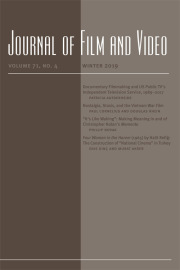
Winter 2019 Vol. 71 Number 4
On July 27, 1966, Turkish film director Halit Refi angrily left a panel discussion on Turkish cinema. According to Refi, the panel had expanded from a discussion of Turkish cinema and its future and turned into a courtroom in which Turkish filmmakers were put on trial. Refi, was insulted at being framed as the enemies of society.

Movie Workers: The Women Who Made British Cinema
by Melanie Bell
After the advent of sound, women in the British film industry formed an essential corps of below-the-line workers, laboring in positions from animation artist to negative cutter to costume designer. Melanie Bell’s use of oral histories and trade union records presents a vivid counter-narrative to film history, one that focuses not only on women in a male-dominated business, but on the innumerable types of physical and emotional labor required to make a motion picture.
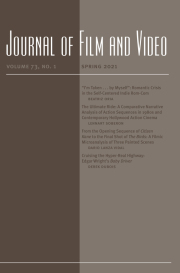
Summer 2009 Vol. 66 Number 2
Feminist Auteurs: Reading Women’s Films (review), by Michael Brian Faucette
Geetha Ramananthan analyzes female directors and how they use their abilities as filmmakers to acknowledge or attack cultural factors such as race, class, gender, voyeurism, and the repression of female desire.

Josephine Baker and Katherine Dunham: Dances in Literature and Cinema
by Hannah Durkin
Josephine Baker and Katherine Dunham were the two most acclaimed and commercially successful African American dancers of their era and among the first black women to enjoy international screen careers. Hannah Durkin investigates Baker’s and Dunham’s films and writings to shed new light on their legacies as transatlantic artists and civil rights figures.
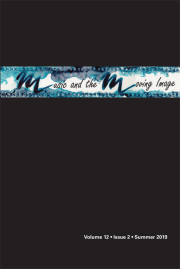
Summer 2019 Vol. 12 Issue 2
This paper proposes an ethnomusicological approach to Djibril Diop Mambéty’s films as a means of reading their diverse musical soundscapes. It demonstrates how this approach delineates a reclamation of Josephine Baker – an international figure who has been objectified for her race and gender.

Queer Timing: The Emergence of Lesbian Sexuality in Early Cinema
by Susan Potter
In Queer Timing, Susan Potter offers a counter-history that reorients accepted views of lesbian representation and spectatorship in early cinema. Potter sees the emergence of lesbian figures as only the most visible but belated outcome of multiple sexuality effects. As she pursues a sense of “timing,” Potter stages scenes of the erotic and intellectual encounters shared by historical spectators, on-screen figures, and present-day scholars.
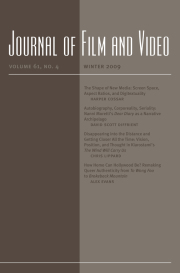
Winter 2009 Vol. 66 Number 4
Figures of Resistance: Essays in Feminist Theory (review), by Montré Aza Missouri
Figures of Resistance is a comprehensive collection of critical essays on feminist film theory and lesbian representations by pioneering feminist scholar Teresa de Laurentis.

Pink Slipped: What Happened to Women in the Silent Film Industries?
by Jane M. Gaines
Women held more positions of power in the silent film era than at any other time in American motion picture history. For example, Gene Gauntier, the face of Kalem Films, also wrote the first script of Ben-Hur. Using individual careers as a point of departure, Jane M. Gaines charts how women first fell out of the limelight and then out of the film history itself. A more perplexing event cemented their obscurity: the failure of 1970s feminist historiography to rediscover them.
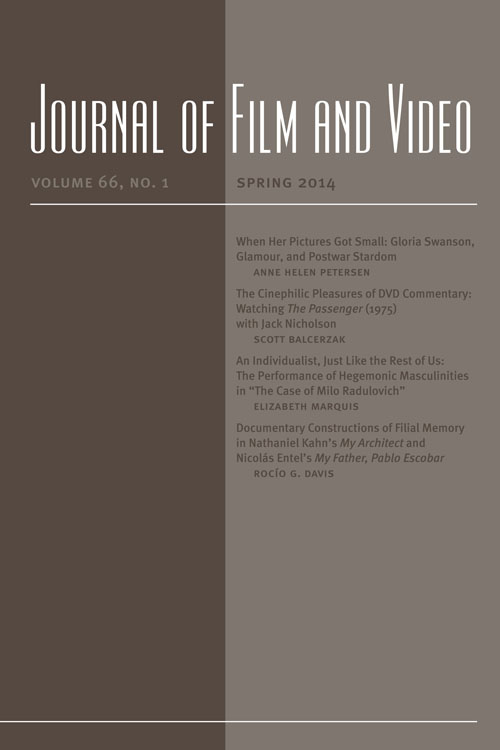
Spring 2014 Vol. 66 Number 1
When Her Pictures Got Small: Gloria Swanson, Glamour, and Postwar Stardom, by Anne Helen Petersen
Gloria Swanson’s forays into television featured a facsimile of Swanson’s star image from the 1920s: classically glamorous, opulent, urban, and thoroughly unironic.

Movie Mavens: US Newspaper Women Take On the Movies, 1914-1923
Edited by Richard Abel
During the early era of cinema, moviegoers turned to women editors and writers for the latest on everyone’s favorite stars, films, and filmmakers. Drawn from newspapers of the time, Richard Abel returns these women to film history with an anthology of reviews, articles, and other works.

Spring 2018 Vol. 11 Issue 1
Emilie Bernstein: An Interview with Gillian Anderson, by Gillian Anderson
Emilie A. Bernstein orchestrated over twenty films with her father, Elmer Bernstein, beginning in 1991 and ending only upon his death in 2004. She also produced many of the soundtracks of those films.
